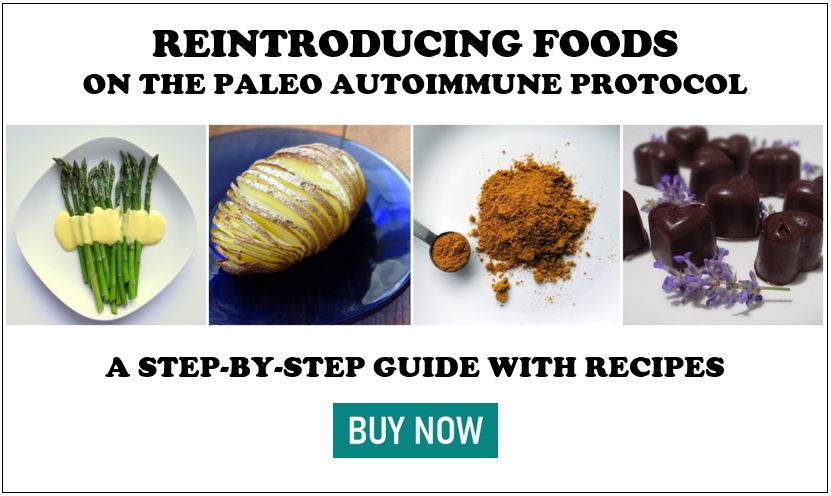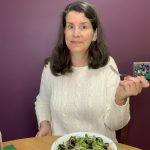“We don’t need to be wise beyond our years. All we need is to be wise beyond our fears.”
~ Anonymous
Misconceptions
That’s a picture of me on my birthday, eating a paleo chocolate cake. Yes, the cake included eggs and cocoa, so how can I be AIP? The answer: I started AIP 12 months before and had successfully reintroduced eggs and chocolate.
When I first researched the paleo diet and learned that it was a lifestyle, not a quick-fix, of course I was disappointed. Who doesn’t want a quick fix? Then I saw the AIP (also known as the paleo autoimmune protocol), and thought, ‘Are you kidding me?! How can I eat such a restricted diet forever?!’ I misunderstood: I thought that since the paleo diet was a permanent one, so was the AIP. I think a lot of people make this mistake. The AIP is actually an elimination diet, designed to be temporary. It removes common food intolerances, allowing the inflammation in your body to calm down and healing to begin to take place. Once you see clear improvement in your autoimmune condition, the next step is reintroductions. It’s a slow, careful process, where you test each food on the AIP, to see if it’s good or bad for you. Everyone’s different in which foods they can reintroduce, but almost everyone can expand their diet in some way, and a diverse diet is both more enjoyable and more nutritious.
A lot of the AIP bloggers, myself included, offer our blogs as resources for people going through the elimination phase of the AIP. That’s the hardest menu to navigate, especially when you first make the switch. A lot of your standard meals are no longer an option, and it helps to have guidance on the foods you can eat. A side effect, though, is that many people think we are all still strict AIP. It’s not true. None of us are. So this article is designed to show you what life on the AIP looks like long-term. There are certain aspects that are forever, like eating nutrient-dense foods and prioritizing a healthy lifestyle. When it comes to the food restrictions, though, it’s all about personalization, and finding the diet that is best for you.
AIP Leaders & Bloggers Share Their Personalized Diets
- Sarah Ballantyne: The author of The Paleo Approach, the blogger behind The Paleo Mom, the teacher of the AIP Lecture Series, and the leading voice of the AIP community. She has Hashimoto’s thyroiditis and lichen planus, and she began experimenting with the AIP in early 2012 (which inspired the research that eventually became her book). She went strict AIP in the Fall of 2012 and began her reintroductions a year later. She found that egg yolks and cultured ghee actually made her feel better, so they are now a regular part of her diet. She can also eat seed-based spices freely. Some other foods she can enjoy in small portions once or twice a week (but not daily) are: chocolate, nuts, seeds, egg whites and coffee. The biggest thing she learned is how much her lifestyle affects her food tolerance: “When I am working late nights (like while finishing the cookbook) or my stress level is unusually high, I find my tolerance for all of these foods diminishes and I have to go back to square one (and frustratingly, that’s when I crave these foods more). My healing really sped up when I learned how to meditate, go to bed earlier, and support my circadian rhythms (by spending time outside during the day and wearing amber-tinted glasses in the evening). For me, my healing journey has been just as much about lifestyle as it’s been about food.”
- Mickey Trescott: The author of the Autoimmune Paleo Cookbook and one of the bloggers behind Autoimmune Wellness. Her AI challenges are Hashimoto’s and celiac. If you follow her on Instagram, you know she’s been able to reintroduce foods, because she often shares photos of her expanded meals. She eased herself into the AIP in late 2011. She tested some reintroductions after a few months, but found that for the most part, she needed more time to heal. At first, she could only tolerate seed-based spices and limited soaked nuts and seeds. The longer she was on the AIP, the more she was able to reintroduce. Now, 2 years later, she can eat the following foods occasionally: all nuts and seeds (except cashews and peanuts), soy-free eggs, fresh legumes (green beans and peas), some nightshades (potatoes and peppers), white rice, and alcohol (wine and hard cider). She limits herself, enjoying nuts/seeds/eggs a couple of times per week, and the rest of the foods a few times per month. Otherwise she eats strict AIP the majority of the time. She finds if she overdoes any of the reintroduced foods, she doesn’t feel her best. When I asked her what lifestyle change had the biggest impact on her healing, she answered, “Sleep!”
- Eileen Laird: You all know me. I’m the blogger here at Phoenix Helix and the author of A Simple Guide to the Paleo Autoimmune Protocol and Reintroducing Foods on the AIP. With the goal of reversing rheumatoid arthritis, I began the AIP in January 2013. I began my reintroductions just 6 weeks later, but I had been paleo for 6 months before that, and did the reintroductions very slowly over 5 months’ time. I am able to enjoy the following foods regularly: fruit-based spices, seed-based spices, seed and nut oils, whole eggs, white rice, and homemade dark chocolate. Once or twice a month, I enjoy a glass of wine, and I save nuts for special occasions (like a pumpkin pie with a nut-based crust on Thanksgiving.) If I had to pick the one lifestyle change that impacted my healing the most, I would say meditation. When I was flaring, it was the one thing that could give me peace; it didn’t remove my pain, but it did soothe my sadness/anger/fear, and that was a huge gift.
- Anne Angelone: A functional medicine practitioner and author of the FODMAP-Free Paleo Breakthrough. Her AI challenge is ankylosing spondylitis, and she started strict AIP in 2012 and began reintroductions 6 months later. She can now enjoy the following foods daily: nuts, seeds, coffee, cocoa, and seed based spices. When I asked what lifestyle change had the biggest impact on her healing, she said exercise: yoga and swimming specifically, and the more she heals, the greater her strength and endurance.
- Jo Romero: The author of the AIP Cookbook, SPICE. She turned to the AIP in July 2013, to heal her psoriasis, and started the reintroduction process 30 days later. She can now eat fruit-based spices, seed-based spices and whole seeds daily, egg yolks once a week (but not egg whites), white rice once a week, cooked tomatoes once a fortnight (but can’t tolerate raw), goat cheese once a month (but no other dairy), and nightshade spices once a month. She also enjoys dark chocolate on special occasions, but doesn’t eat it regularly, because she finds it causes sugar cravings, and too much sugar makes her psoriasis flare. Here’s what she says about the power of lifestyle: “By far the biggest lifestyle change that accelerated my healing was managing stress. I went to see a counselor to learn mindfulness techniques, took up yoga and I make sure I get half an hour purely to myself every day, just to sit and relax. It’s not much, but it has made a HUGE difference.”
- Whitney Ross Gray: The blogger behind Nutrisclerosis. You can tell by that name that she’s reversing MS. She started the AIP in 2010 and went through the reintroduction process a year later. She now enjoys all spices (fruit-based, seed-based and nightshade), but avoids nightshade vegetables. She adds egg yolks to recipes for their nutrient-density, but avoids whole eggs. She’ll eat seeds in a recipe, but doesn’t seek them out for snacks, and the only nut she eats are brazil nuts (for their selenium). She enjoys white rice daily, dark chocolate once or twice a week, tequila once or twice a month, and the occasional gluten-free baked good as a special treat. When it comes to lifestyle, she agrees with Mickey, naming sleep as absolutely essential.
Tips for Personalizing the AIP For You
- Wait until you are ready for reintroductions. As you can see in the examples above, the timing is different for everyone. You want to see clear improvement in your autoimmune condition first. This does two things: it shows that healing is taking place, and it gives you a baseline to test your body for reactions to inflammatory foods. How you feel mentally/emotionally makes a difference, too. If you’re afraid of reintroductions, postpone them until you’re ready. If you are feeling overwhelmed by the AIP and are close to cheating or bingeing on non-AIP foods, go through the reintroduction process instead.
- Do your reintroductions slowly and correctly. The reintroduction process can actually be harder than the elimination phase, because it requires such patience and focus. The most common mistake is rushing the reintroductions, muddying the results. I wrote my reintroduction guide to help. This is where your body communicates with you, which is empowering and important to your healing process. You want to do it right.
- Learn what you can eat daily vs. occasionally vs. not at all. The reintroduction guide includes a two-stage reintroduction process. Some foods are immediately inflammatory, and we need to avoid them altogether. Some are mildly inflammatory, which only becomes clear when we eat them daily. Some are neutral or even positive, and it’s a joy to incorporate them back into our daily diet.
- Don’t give up. If at first you aren’t able to reintroduce many foods, try again in 6 months. Often, the more you heal, the more foods you will tolerate. Mickey is a great example.
- Notice and celebrate how far you’ve come. So often, we focus on what is still wrong, that we discount all the healing that has already taken place. This applies to the foods we can and cannot eat, but even more importantly to our health: the abilities we lost that we have started to regain, and the negative symptoms that were disabling that have started to disappear. Living in a space of awareness and gratitude is a healing place. It feels good to body and soul to mark the milestones.
Parts of the AIP are Forever
Let’s look at that picture at the top of the post again. I look pretty happy right? Who doesn’t love cake? However, that’s not my daily life on Personalized AIP. That was a special occasion, worthy of the sugar overload, and I savored every bite. Daily life on the AIP is meant to nutrient-dense, and no matter how long you’ve been on this diet, your body is never too full of nutrients. When reversing autoimmune disease, we need to provide our bodies with the best building blocks possible, and that means incorporating seafood, organ meats, fermented foods and a wide variety of vegetables into our meals every week.
We also need to pay attention to that all-important lifestyle piece. While food is foremost in our mind, because we’re learning about food intolerance, lifestyle is equally important. Poor lifestyle choices can make our autoimmune disease flare just as fast as poor food choices. So get enough sleep every night, focus on reducing stress, incorporate joy and relaxation into your day, get outside in the fresh air and sunshine, try meditation or something similar, and find a way to exercise that supports your health. All of this is essential to healing, now and forever.
You May Also Be Interested In
This post was originally written as a guest post for Autoimmune Wellness.











This is great! We have a little one who is dairy free, nightshade free, and almond free, so we have put him on a mostly AIP diet, but he can have bread (if it’s dairy free), eggs, white rice, and nuts other than almonds. Having other allergies in the house including one who is dairy free, soy free, sugar free, and gluten free, the AIP recipes have helped a ton in expanding their options.
I agree! AIP is wonderful for helping families with allergies. You’re such a caring mother, and I’m so glad your little one has some successful reintroductions, too!
Hi Eileen, I really appreciate all the work and advice you put out into the world..
I’ve been on AIP for 6 months, and previously was strict paleo for 2 years… I wondered if you have an opinion on reintroductions while still on immune suppressants. I cannot come off my immune suppressant and haven’t managed to find resolution of any symptoms. Any reintroduction I’ve tried hasn’t had any obvious impact (ie. no noticeable negative effect) so I feel like it’s impossible to know what I can and can’t reintroduce. Sleep, yoga meditation and reiki are all part of my lifestyle – however I don’t want to stay on AIP forever. Any advice you can give would be appreciated with regard to immune suppressants & AIP. Thanks!
Hi Bailey. You don’t need to go off your medication to do reintroductions. Many people do best with a combination of diet & medication. That said, you do need some kind of baseline to be able to discern food reactions, and I understand that sometimes medication can blunt those reactions. Not always, but that appears to be happening with you. In many ways, this is a good thing. It means you are more likely to do well on an expanded diet. I agree that you want the least restrictive diet possible, while also eating for health. Because your situation is unique, you might want to work 1:1 with an AIP coach who can help you figure this out and share some educated advice. Conscious Autoimmunity is a team of 2 health coaches who specialize in the reintroduction process.
HI Eileen,
So pleased your wrote this article. As I think there are too many people around who see AIP as the end point rather than the start of the healing journey, and it is more than just food – it is about nourishing the body holistically. And yes I do find that going strict AIP when life is more demanding of me does help me get through those times with greater ease. For me, the biggest impact outside of food was making time for myself (self care) – something I found harder to change and stick to than the way I eat! It is a constant re-evaluation and checking in with oneself. Sheryl
Sheryl, I couldn’t agree more! Thanks for sharing your experience.
Hi Eileen – I know this post is extremely old now, but I’m just stumbling across it – it’s very encouraging! Question for you – is the benefit of white rice over other (whole) grains that it’s easier to digest? I’ve had trouble deciding how much to incorporate grains into my diet (that I can tolerate..just a few GF grains). I probably would not consider it given a different scenario, but I have enough food sensitivities (histamine intolerance, resistant starch issues, among others) that I can eat about 25-30 foods, so any variation is appreciated, although I try to limit grains to 3-4 times a month (which may even be frowned upon by some in the paleo-sphere!). Do you have any resources or insight on this? My decision has mostly revolved around learning what my body can tolerate without sacrificing nutrient density, although I had no idea a lot of AIPers eventually include white rice as a regular staple! I’m wondering if that should be my go-to over some other choices. Thank in advance!
Hi Fallon Lee. I think your decision making process sounds very wise – learning what your body can tolerate without sacrificing nutrient density. I have a post that will answer your questions in detail: What’s Up With White Rice?
I am starting my own healing journey with RA. Your story brings me hope and strength. Thank you for sharing it with the world. Your generosity and kindness in doing so, makes my heart very happy. I would like to do the same with my own walk into the wilderness. It is brave souls like yourself that offer a light out there in the forest for those of us who are standing out here contemplating whether or not we should walk in those dark woods. Perhaps one day we shall find one another. I am deeply grateful.
What a beautiful comment, Lona. Thanks so much for writing. Wishing you wellness on every level!
How have things been going with the meds?
Thanks for asking, Lona. It’s really too soon to say. I plan on writing an update in January. Things should be more clear by then. Medication trials require so much patience.
Hi Eileen: Thoroughly enjoy your blog with great researched and detailed information. After 20+ years of treatment for Rheumatoid Arthritis and 32 years eating vegetarian/vegan diets, I decided to try AIP. It was pretty rough on my body for a few months, but I continued and it is now been 2 years 3 months on strict AIP – but not much improvement no matter what I do (including digestive aids, probiotics, supplements). I have had all appropriate testing done. All that said, I’m so used to eating AIP and enjoy it that I don’t have any desire to add back lots of other foods. AIP seems like such a clean, pure way to eat. And I highly recommend it for folks that need to lose weight. My weight has remained healthy and stable all this time. Please don’t stop doing what you are doing!! We need you!
Hi Denise. Thanks for sharing your story. I’m glad you enjoy the AIP so much, but I wish for your sake you were also feeling better. I’ll be interviewing a paleo rheumatologist on my podcast in July, so she might have some wisdom that will help. Be sure to listen in! Wishing you health and happiness.
Hi Eileen, Thank you so much for writing this post – You rock! Do you feel that food sensitivity testing is a helpful adjunct to the elimination/reintroduction process? Have any of the above ladies (yourself included) gone this route and used food sensitivity testing in tandem? If so, did they find the testing accurately correlated to what they discovered through their elim/reintroduction process? If so, which food sensitivity tests did they have done? There seems to be a lot of conflicting info about the accuracy/effectiveness of food intolerance testing…I sure would love to hear back from you on this 🙂 I’m trying to determine if this would be a helpful way to determine what foods might be problematic for me.
Hi Suzie. Unfortunately food sensitivity testing is notoriously inaccurate, and the people who say otherwise are those who are selling the tests. I wish they were accurate! It would be a lot easier. I wrote an article with more details: Why Food Intolerance Testing Doesn’t Work.
Thank you for this post. I had been paleo for 6 months then AIP for the past 18 months. I started reintroducing foods over the past 6 months very slowly, some things did not work the first time but worked out after waiting longer. Your posts are always so informative and cover things that are not addressed on other sites.
Eva, thank you so much for sharing your experience. It sounds like you did reintroductions the right way – slowly and carefully. Congratulations on your successes – each food welcomed back into the kitchen is a cause for celebration.
Thank you this was so helpful to read and very timely. We are all so different. I am two and half months into full blown AIP to heal my psoriasis which I have had since I was a young girl; I just turned 50. My psoriasis has never been better but I am experiencing bloating and gas sometimes and have lost my regular bowel movements; perhaps a leaky gut. I am hesitant to reintroduce foods as it requires so much patience and I gave up and threw in the towel last time and just continued Paleo. I so appreciate the AIP community and all that is shared; the stores are inspiring and keep me motivated.
Hi Sandra. Have you listened to my recent podcast interview with dietitian Amy Kubal? She offered some troubleshooting advice for digestive issues, which may help you.
I listened to the podcast with Amy Kubal and it was very informative and helpful. Thank you for all you do for this community.
My pleasure, Sandra. I’m so glad the information was helpful!
Thank you for this Eileen. I know this is not a lifelong process, but it sure does feel that way sometimes. It seems every time I go to reintroduce something, I flare-up, so have had to go back to the beginning a lot during this adventure. I do not mind eating this way and if it should turn out that I must forever, so be it. At 68 years old, I’m sure it won’t matter too much. I’ve just started blogging my journey as well as I know there are so many people out there who are simply not aware of the things they can do to make their lives much easier. However, saying that, a lot of people simply do not want to change the way they eat – too bad because it’s really not that bad! Thank you again Eileen.
Welcome to the blogging community, Louise! Some people do need a longer time to heal before successful reintroductions. I know that was true for Mickey. My hope for you is that your diet is delicious and nutritious, always.
I started this path about 4 months ago…what I am unclear on is how do we know if we have healed? Do we just feel “really good” and then we know? Or is it feeling good plus the lab tests..
That’s a complicated question, Donna, because I don’t believe healing is a something we achieve in the past tense. I believe autoimmune healing is a lifetime journey. We all need to continue to take great care of ourselves to feel our best. If you’re asking when you know you are ready for reintroductions – that’s when you have improved enough to have a clear baseline to test for food reactions. You don’t need to be in remission. You just need to have had marked improvement in your autoimmune symptoms – and since this is about communicating with your body, lab tests aren’t necessary (although they might be helpful for other reasons – they’re just not necessary to the food reintroduction process).
This was an awesome post!!!! Thank you so much!
You’re welcome, Corianna!
Thanks for your prompt response.
How long does it usually take to notice some changes – months at a guess?
How long before you felt some improvement?
Are there people this diet doesn’t work for?
Thanks again.
AIs are horrible conditions. The pain and the disability are shocking.
I’m hoping this assists me.
How fast we heal is very personalized. Some people start to improve within a month, for some it takes longer. If after 3 months, you haven’t improved on the AIP, that’s where troubleshooting comes into play. For example, there might be a gut infection that’s interfering with healing, and don’t underestimate the power of stress. Don’t worry about that now, though. Dive into the AIP, and see what it alone can do. Also, I got a testimonial on my Facebook page today that I thought you’d like to hear: “Mild psoriasis all my life and then severe psoriatic arthritis that went undiagnosed for 12 years! Within 6 moths I was off all NSAIDs (had refused to take Enbrel) and lost 45 pounds. The next 6 months I regained use of my left hand and started gaining energy back. (Bones in my hand are completely degenerated but I can now use t somewhat. Before diagnosis, it was inflamed and could not be touched at all!) I had severe leaky gut from years of ibuprofen use but it’s healing quite well. I’m 17 months in and basically paleo without the almonds and eggs, and I do eat white rice I haven’t had a major flare up since last November. Now I get warning signals rather than flares. Don’t give up, it’s so very worth it!!!” ~ Amy
Great Blog Eileen,
So many of the paleo blogs are linked to Hashimotos or stomach issues as opposed to joint issues.
I have severe psoriatic arthritis and have been put on an anti-TNF.
Do you think there is any harm in is staying on medication whilst being on AIP?
Also do you know of anyone who has had success with AIP and psoriatic arthritis?
Maybe you could write some stuff specifically on joint health and diet. It is lacking out there in the AIP world.
Thanks
Since healing through diet and lifestyle takes time, the recommendation is to stay on your medication until your symptoms improve, and then work with your doctor to try tapering your medications as you no longer need them. And I have indeed known people who reversed their psoriatic arthritis through the AIP. Wishing you health on every level!
Hi Eileen,
I was really encouraged reading about your healing journey! I don’t have any diagnosed
autoimmune diseases, but decided to go AIP 6 months ago to deal with digestive
and hormonal issues. My concern is that, while I have seen improvement, I fear that
I am reacting to foods I’m still eating and I haven’t even tried reintroductions. I am
wondering if I should try the GAPS diet and then try reintroducing foods.
Any thoughts?
I would recommend you work with a nutritional practitioner at this point. There are so many possible troubleshooting steps, and GAPS is just one option. I would hate to see you add unnecessary restrictions and maybe miss the key that might help you. Have you heard of Paleo Mom Consulting? Everyone there is great!
Thanks so much for the suggestion. Actually, that is the path I was persuing! I really appreciate your advice!
Hi Eileen, thanks so much for writing this post! We did AIP for 1 month but had to revert back to regular Paleo because I didn’t have enough AIP cooking experience and I was running out of things to feed my family. We’re planning to give it another go-round soon, but I’m so happy to hear that it should hopefully be a limited-term adventure. I know my older daughter will be cheered to hear that there is at least the possibility of reintroducing foods after we go full AIP.
Absolutely, Viva! I believe the reintroduction process is as important as the elimination process.